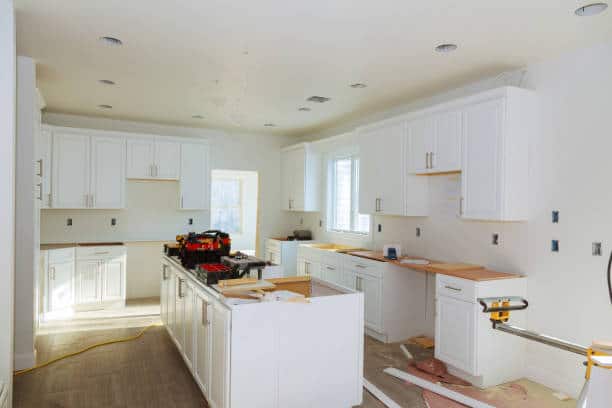Home remodeling can transform a living space, enhancing both function and aesthetics. In Washington, the average remodeling cost varies depending on the scope of the project, with kitchen and bathroom renovations typically requiring a larger investment.
Current trends in the Washington area reflect a growing interest in sustainable materials and open-concept designs. Many homeowners are looking for ways to modernize their spaces while being environmentally conscious. Incorporating the latest design trends can significantly increase a home’s value and appeal.
Understanding the Home Remodeling Landscape in Washington
The home remodeling landscape in Washington is marked by unique trends, specific cost considerations, and an important permitting process. Understanding these elements is essential for homeowners planning a renovation.
Current Trends in Home Design and Renovation
Homeowners in Washington are increasingly drawn to open-concept layouts, maximizing light and space. Sustainable building practices also gain traction, with a focus on energy-efficient materials and appliances.
Popular design elements include natural wood finishes, stone accents, and bold color palettes. Outdoor living spaces are becoming vital, highlighting decks and patios for entertaining.
Smart home technology is on the rise, integrating systems like lighting and security for convenience and efficiency. Attention to detail in smaller spaces, such as bathrooms and kitchens, is also prevalent, with upgrades like high-end fixtures and custom cabinetry.
Average Costs and Budgeting for Your Project
The average cost of home remodeling in Washington varies significantly based on project scope and location. Kitchen remodels can range from $20,000 to $80,000, while bathrooms typically cost between $10,000 and $30,000.
Factors influencing costs include material selection, labor, and the complexity of the renovation. Homeowners should consider obtaining multiple estimates from general contractors in Washington to ensure competitive pricing.
Permitting Process and Legal Considerations
The permitting process in Washington is vital for any significant home modification. Most projects require permits, especially for structural changes, electrical work, or plumbing.
Homeowners should begin by consulting local building departments to understand specific regulations. Deadlines and requirements can vary by city or county.
Hiring a knowledgeable general contractor can streamline the permitting process. They often have experience navigating local codes and can assist in filing the necessary paperwork. This ensures compliance with legal considerations and minimizes potential delays.
Planning Your Home Remodeling Project
Effective planning is essential for a successful home remodeling project. Key considerations include setting goals, choosing materials, and adopting sustainable practices. These factors will guide homeowners through the process and help achieve desired outcomes.
Setting Realistic Goals and Timelines
Homeowners should begin by defining what they want from their remodeling project. This involves outlining the specific areas to remodel and the desired style or function.
Involvement of a general contractor can streamline this process, providing expert guidance on feasibility and design options.
Timelines must be realistic, factoring in permitting, material availability, and potential delays. Creating a detailed timeline with milestones can help keep the project on track.
Selecting the Right Materials and Finishes
Choosing materials is critical for both aesthetics and durability. Homeowners should consider factors like cost, maintenance, and environmental impact.
Popular choices include:
- Flooring: Hardwood, laminate, or tile
- Countertops: Granite, quartz, or recycled materials
- Paint: Eco-friendly options to reduce VOC emissions
Consulting with professionals can provide insights into the best materials for specific areas of the home.
Green Remodeling: Sustainable Practices
Sustainable practices are increasingly important in home remodeling. Homeowners can reduce their environmental impact by incorporating eco-friendly materials and energy-efficient systems.
Consider the following sustainable options:
- Recycled materials: Using reclaimed wood or recycled glass
- Energy-efficient appliances: Lower energy consumption and costs
- Insulation: Investing in high-quality insulation can improve energy efficiency.
Engaging with a contractor knowledgeable in green remodeling can help identify opportunities to maximize sustainability. This approach may involve upfront costs but often leads to savings on utilities over time.
Working with Professionals
Engaging professionals can significantly streamline the remodeling process. Choosing the right general contractor and maintaining effective communication are crucial elements to a successful outcome.
Choosing a General Contractor
Selecting a general contractor near me in Washington is essential for a smooth remodeling experience. Start by gathering recommendations from friends, family, or online platforms.
Consider conducting interviews with potential candidates. Ask about their experience, project portfolios, and licensing. Verify their credentials and check for insurance coverage.
A reliable contractor should provide a detailed contract outlining project scope, timelines, and costs. Look for someone who values transparency and aligns with your vision.
Effective Communication Throughout the Project
Clear communication can prevent misunderstandings and keep the project on track. Establish initial expectations for updates and meetings.
Use project management tools for task tracking and to share documents. Regular check-ins allow for adjustments if needed, ensuring that both parties remain aligned.
Encourage feedback. A trusted contractor should be open to suggestions and concerns. Inform them of any design changes promptly, avoiding last-minute delays.
Maximizing Your Investment
Home remodeling can significantly enhance property value when approached strategically. Investing the right amount of time and resources into targeted improvements ensures a better return on investment.
Improving Home Value with Strategic Remodeling
Focusing on high-impact areas such as kitchens and bathrooms tends to yield the highest returns. Key improvements include:
- Updating Appliances: Energy-efficient appliances appeal to buyers and save on utility costs.
- Modern Fixtures: Sleek faucets and lighting fixtures can greatly enhance aesthetics.
- Open Layouts: Removing non-structural walls creates a more spacious feeling, which buyers often prioritize.
Investing in curb appeal through landscaping and exterior updates can also influence buyer perception.
Maintaining Your Home After Remodeling
Ongoing maintenance is crucial for preserving the value achieved through remodeling. Neglecting upkeep can lead to costly repairs and diminished appeal over time.
Essential maintenance tips include:
- Regular Inspections: Conduct yearly inspections for plumbing, electrical, and structural integrity.
- Routine Cleaning: Keep remodeled areas clean to prevent deterioration. For instance, a well-maintained kitchen remains attractive.
- Timely Repairs: Address small issues promptly to prevent larger problems from developing.
Implementing these practices helps maintain the investment’s value while ensuring the home remains desirable in a competitive market.








